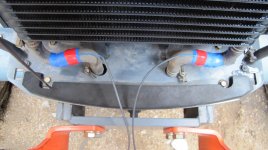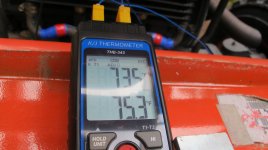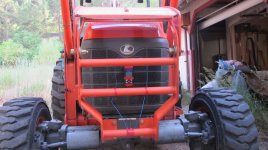rScotty
Super Member
- Joined
- Apr 21, 2001
- Messages
- 9,658
- Location
- Rural mountains - Colorado
- Tractor
- Kubota M59, JD530, JD310SG. Restoring Yanmar YM165D
I should have updated this a month ago or more now...
I took apart the entire thing as someone pictured (thank you so much), ran the springs\misc parts through my ultrasonic cleaner, re-assembled, and it works... mostly.
However... I still do not have full pressure to one side... for example I can't use the backhoe to lift the rear end over a ditch in one direction, but I can the other direction with so much force I'd throw myself out if not paying attention or running to high RPM when doing so
I've put about 60hrs on the backhoe since then 100% use of removing stumps and now my thumb cylinder is leaking around the cylinder rod (already replaced on my dipper), and in addition to that my main cylinder is leaking around the threads... hoping that's just needing to be tightened up but it's a bit upsetting to see so much issues in something that was barely used for years until now. (It was used to lift and move things monthly since I've owned it, and remove a stump or 2, but now I'm using it for hours on end.)
Question -- For those of us who had this problem do you operate the backhoe for hours on end and\or in high temperatures? I noticed I was getting really hot when outside air temp was only 70-75 and it was from the AUX hydraulic lines to the left (not in use) radiating heat... I cleaned out my hydraulic cooler fins and ran it for 2-3hrs and the AUX lines never got hot that I felt them!! That was nice. Does Kubota have an "overheat" hydrlauic fluid warning? Or how do you know it's overheating? (I personally can tell after 2-3hrs I start to smell the fluid, not burn, its just "its heated up now I smell it.) I'm just curious if i'll know (alarm) if I overheat it, or if not, and if not, I'll change all fluids.
Keep up the good Science! We are slowly accumulating information. We will figure this out someday; I've no doubt. And it is fun to be able to work on something that is so technical that
Kubota couldn't make any progress on it.
To answer your question... Yes, I have noticed that the swing function does change at high temperatures. After hours of operation there is sometimes a little change in how the swing responds to the lever command - particularly at the very extreme of the swing. It occurs as a slight hesitation between the lever movement and the swing movement. Normally they are simultaneous. I see this on the left swing more than the right, but that might just be because I use that side for small movements and so it is more obvious.
I don't know if there is a hydaulic fluid heat warning. The JD310 has a converter temperature gauge, but not the M59.
One thing I have encountered from reading & study is the idea that that trans/hydraulc fluid differs from motor oil in how it ages with temperature. That seems to be common knowledge, but just how and how much is harder info to find.
Some literature mentioned that only a very few high temperature excursions might drastically reduce the lubricity. However, the aging was said to be very much non-linear and I haven't seem any real data.
I may go clean off those radiators today and maybe put some temperature gauges on the hydraulic lines. Will keep us posted.
rScotty



